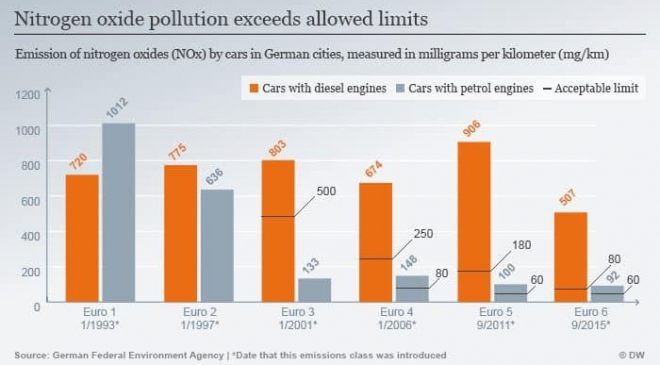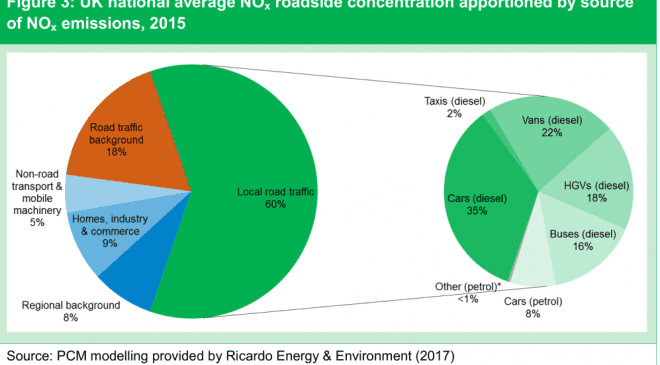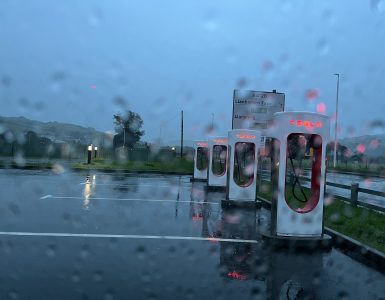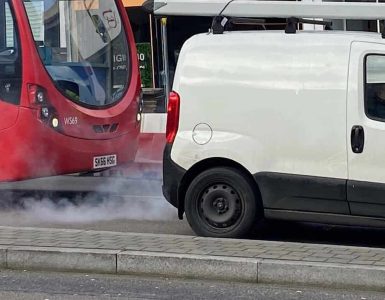Lobbyists for the car industry for diesel technology (including some of the motoring press and motoring experts) say that older diesel cars are dirty but new Euro 6 diesel cars are clean. They say that the demonisation of diesel in the mainstream media is ill informed and confusing drivers into not buying the clean diesels that are lovely and clean. On a particularly optimistic day they use phrases like “emissions of Euro 6 diesels are comparable with a those from petrol cars” It’s true you can compare Euro 6 diesel emissions to petrol cars, an average new Euro 6 diesel is still between 6 and 7x more polluting than the 60mg/km NOx limit that over 90% of petrol models achieve. In fact the average NOx from petrol cars is even lower than the legal limit – probably around half that – so in the real world a Euro 6 diesel may poisoning the air with as much as 14x the NOx.
So whats the evidence? Below are some of the charts from different independent sources of real world emissions data and the links to the reports they originate from. Euro 6 testing ( except for cars launched since sept 2017) is done is a lab in conditions that bear no relation to the real world emissions and can easily be manipulated.
By comparison “real world” or “on the road” testing uses 2 methods to find out what these cars emit when driving normally. The first is PEMS where equipment is attached to the car while it is driven around over several hours so the average emissions can be calculated in different driving conditions from urban to motorway and in between. The second is remote sensing, where equipment is set up the at the roadside that takes a single snapshot of emissions of every passing vehicle. Remote sensing results will depend on where it is set up but can compare thousands of new and old cars per day but the results for each are a 1 second snapshot of the passing vehicles. Numberplate recognition identified each car to match its emissions.
Before we get to the charts how else can you tell new diesels are still dirty?
- Use your nose. Diesels produce a pungent smell and that is caused by the NO2 gas from the exhaust. If a street full of traffic smells it’s almost certainly the diesels you can smell. To test this when you see a parked idling vehicle away from any other traffic see if you can smell it from up to 5 to 20 metres (thats 1 to 4 car lengths away). Never sniff the exhaust close up on any car! Then see if its diesel or petrol. Most cars will have a D in the model badge if they are diesel. Once you know the smell you can spot a single passing diesel car just by the smell as it passes. This smell lingers for up to half a minute. It’s the smell of our air being poisoned by a diesel car.
- Ask yourself if new diesels complied with the Euro 6 80mg/km limit that applied since 2015, why would the carmakers lobby to raise the NOx limits in the new Euro 6 real world RDE tests. Until 2020 a real world result of 163mg/km will be a pass and in 2020 this falls to 120mg. So even in 2020 carmakers expect most diesels to fail the 2015 Euro 6 NOx pollution limit of 80mg/km and still be twice as dirty as petrol cars.
- Ask yourself if would people take enormous risks cheating in an exam if they knew they would pass it anyway? Carmakers have risked their reputations, fines, investigations and jail to ensure their diesels pass lab tests while avoiding the true cost of making and running diesels that would be cleaner most of the time on the road. They also spent a lot of money lobbying the EU to ensure the lab test rules allowed the manipulation and cheating to take place. Why would you do that if your cars were clean in real driving conditions?
The charts and the data
2021 Source – The Brussels study by True Emissions
Interesting because it shows the level of NOx pollution from Diesel and Petrol Vehicles on the Euro 3, 4, 5, 6 and the latest 6d temp standards
- It shows about 80% NOx pollution from Euro 4, 5 and 6 vehicles
- New Euro 6 D diesels sold since 2019 were better but still over 50% higher than petrol vehicles on average
- Diesel Particulate Filter (DPF) malfunctions were detected in 5% of the fleet fitted with the technology. These high emitting vehicles are estimated to be responsible for more than 90% of total particle number emissions from the group tested
Source German Federal Environment agency and published by Deutsche Welle in Feb 2018
What does it show
This compares the average real world emissions for diesel cars (grey bars) and petrol cars (orange). For Euro 3 onwards the legal maximum permitted are shown as a lines.
Why is it interesting?
- Petrol cars in 1993 were actually dirtier than diesels cars but by 1997 were slightly cleaner and by 2001 were massively cleaner.
- diesel actually got dirtier with each emission standard except Euro 4 and Euro 6.
- Euro 5 diesels from 2011 to 2015 were the dirtiest diesel models ever made, much worse than a 1993 to 1997 model.
- Euro 6 cars are the cleanest diesels ever made but are still very polluting. On the road on average they fail to meet the even 500mg/km Euro 3 limit set in 2001.

Source 2 – The West Lothian Goverment study
https://www.westlothian.gov.uk/article/23026/Real-Time-Vehicle-Emissions-pilot-project-March-2017
What does it show
In March 2017, a pilot project was carried out in Edinburgh and West Lothian to measure the pollutants generated by vehicles driving in ‘real world’ conditions. The emissions readings of 72,000 cars were taken and matched to DVLA numberplate records. The readings were taken using a highly advanced american remote sensing system that uses lasers. https://www.heatremotesensing.com
Why is it interesting?
The summary page on the link is worth reading directly. “Few of the Euro 6 diesel vehicle groups analysed met the Euro 3 Standards. On average, Euro 6 emissions are only moderately below the in-use levels of Euro 3 to Euro 5 classes;”
Looking at the chart what is even more remarkable is only 7 out of 22 car brands in Europe achieve 2001 Euro 3 compliance on the road. And 7 is counting all the VW group brands – Audi, Volkswagen, Skoda and Seat separately! If you count them as one only VW group, Land Rover, Mini and Toyota manage to comply with a 17 year old emission standard when tested on the road. None achieve Euro 4 or 5 or 6 for diesel cars!
Source 3 – Uk detailed plan for tacking roadside nitrogen dioxide concentrations – July 2017
The UK government’s July 2017 plan was a disappointment in terms of effective action. It’s data showing the arguements for action did not shy away showing why action is needed.
what does the main chart show
Euro 1 to 6 real world emissions from petrol and diesel cars up to buses and trucks
Why is it important
The main lower chart does show the one success of Euro 6. Larger diesel vehicles including HGV’s and buses had to pass a real world test to meet Euro 6. The remarkable thing even on this scale is Euro 6 diesel vans and cars now emit around the same as 40 ton HGVs and buses. The only blots on this good news story is that although most Euro 6 buses have very low emissions some have much higher emissions. The other issue that some road haulage fleets have been – wait for it – attaching cheat systems so enable engines to run without adblue. These Euro 6 trucks will be rendered as dirty as previous standards.
The smaller inset chart shows petrol versus diesel emissions for both cars and vans. Looking at petrol these have had low emissions since Euro 4 while new diesel cars remain around 400 mg/km compared to a legal maximum permitted of 80mg/km. Diesel vans are even worse at over 600 mg/km.

What does the second chart show
this looks at the sources of NO2 pollution
why is it interesting?
Lobbyists often claim only a small part of urban roadside pollution comes from diesel vehicles and smaller cars and vans in particular. This chart from Ricardo used in the Defra report allocates 60% of NO2 as directly attributable to road vehicles. Of that just 8% comes from all the petrol cars compared to 35% from diesel cars
UK national average NOx, Roadside concentrations apportioned by source of NOx emissions.








[…] below shows the real world diesel emissions of 70,000+ diesel cars by brand on the road in the Edinburgh & West Lothian study in 2017. To take Audi as an example when tested on the road their Euro 3 diesels were twice as polluting as […]
[…] to replace. Many owners either leave the DPF faulty or remove it and don’t replace it. If Just 5% of diesels have non performing filters these vehicles can produce as much particulate as 95% of diesels with […]